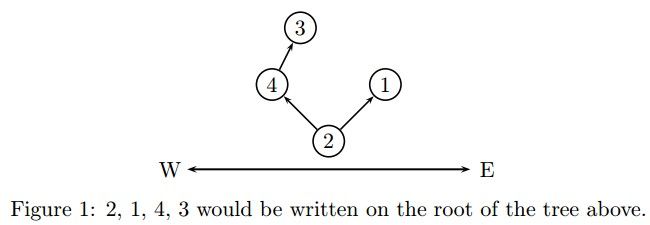HDU5444 2015长春网络赛H题(dfs遍历二叉树 简单模拟)
0)
题意:
精灵们住在一颗二叉树上,为了方便邮递园送信,根结点的房间写了这棵树上的房间号分布,是按先序遍历给出的。(这个题的先序遍历顺序:1访问根结点,2先序遍历东边子树,3先序遍历西边子树),而房间号总是东边的房间小于西边的(不限是否在同一层)。然后给出要接受信件的房间号,将途径房间的房间号一并输出。
1)
#include <iostream>
#include <string.h>
using namespace std;
const int maxn=1010;
char record[maxn];
int sum=0;
struct tree{
int left;
int right;
}tree_1[maxn];
void build_tree(int root,int num)
{
if(root>num&&!tree_1[root].right){
tree_1[root].right=num;
}
if(root<num&&!tree_1[root].left){
tree_1[root].left=num;
}
if(root>num){
build_tree(tree_1[root].right,num);
}
if(root<num){
build_tree(tree_1[root].left,num);
}
}
void dfs_tree(int root,int num)
{
if(num==root&&!sum){
sum=1;
return ;
}
if(num<root&&tree_1[root].right){
record[sum++]='E'; //顺序是,record[sum]='E'; sum++,所以如果根结点不是送信的目标房间,那么record[0]就会被覆盖
dfs_tree(tree_1[root].right,num);
}
else if(num>root&&tree_1[root].left){
record[sum++]='W';
dfs_tree(tree_1[root].left,num);
}
}
int main()
{
int kase;cin>>kase;
while(kase--){
int n;cin>>n;
int root;cin>>root;
n--;
while(n--){
int room_num;cin>>room_num;
build_tree(root,room_num);
}
int m;cin>>m;
record[0]='\0';//'\0'是文件结束符标志,'\n'才是回车,不要混淆
while(m--){
int bk_num;cin>>bk_num;
dfs_tree(root,bk_num);
for(int i=0;i<sum;i++){
if(record[0]=='\0'){
break;
}
cout<<record[i];
}
cout<<endl;
memset(record,0,sizeof(record));
record[0]='\0';
sum=0;
}
memset(tree_1,0,sizeof(tree_1));
}
}
2)
Elven Postman
Time Limit: 1500/1000 MS (Java/Others) Memory Limit: 131072/131072 K (Java/Others)Total Submission(s): 1231 Accepted Submission(s): 700
Problem Description
Elves are very peculiar creatures. As we all know, they can live for a very long time and their magical prowess are not something to be taken lightly. Also, they live on trees. However, there is something about them you may not know. Although delivering stuffs through magical teleportation is extremely convenient (much like emails). They still sometimes prefer other more “traditional” methods.
So, as a elven postman, it is crucial to understand how to deliver the mail to the correct room of the tree. The elven tree always branches into no more than two paths upon intersection, either in the east direction or the west. It coincidentally looks awfully like a binary tree we human computer scientist know. Not only that, when numbering the rooms, they always number the room number from the east-most position to the west. For rooms in the east are usually more preferable and more expensive due to they having the privilege to see the sunrise, which matters a lot in elven culture.
Anyways, the elves usually wrote down all the rooms in a sequence at the root of the tree so that the postman may know how to deliver the mail. The sequence is written as follows, it will go straight to visit the east-most room and write down every room it encountered along the way. After the first room is reached, it will then go to the next unvisited east-most room, writing down every unvisited room on the way as well until all rooms are visited.
Your task is to determine how to reach a certain room given the sequence written on the root.
For instance, the sequence 2, 1, 4, 3 would be written on the root of the following tree.

So, as a elven postman, it is crucial to understand how to deliver the mail to the correct room of the tree. The elven tree always branches into no more than two paths upon intersection, either in the east direction or the west. It coincidentally looks awfully like a binary tree we human computer scientist know. Not only that, when numbering the rooms, they always number the room number from the east-most position to the west. For rooms in the east are usually more preferable and more expensive due to they having the privilege to see the sunrise, which matters a lot in elven culture.
Anyways, the elves usually wrote down all the rooms in a sequence at the root of the tree so that the postman may know how to deliver the mail. The sequence is written as follows, it will go straight to visit the east-most room and write down every room it encountered along the way. After the first room is reached, it will then go to the next unvisited east-most room, writing down every unvisited room on the way as well until all rooms are visited.
Your task is to determine how to reach a certain room given the sequence written on the root.
For instance, the sequence 2, 1, 4, 3 would be written on the root of the following tree.

Input
First you are given an integer
T(T≤10) indicating the number of test cases.
For each test case, there is a number n(n≤1000) on a line representing the number of rooms in this tree. n integers representing the sequence written at the root follow, respectively a1,...,an where a1,...,an∈{1,...,n} .
On the next line, there is a number q representing the number of mails to be sent. After that, there will be q integers x1,...,xq indicating the destination room number of each mail.
For each test case, there is a number n(n≤1000) on a line representing the number of rooms in this tree. n integers representing the sequence written at the root follow, respectively a1,...,an where a1,...,an∈{1,...,n} .
On the next line, there is a number q representing the number of mails to be sent. After that, there will be q integers x1,...,xq indicating the destination room number of each mail.
Output
For each query, output a sequence of move (
E or
W ) the postman needs to make to deliver the mail. For that
E means that the postman should move up the eastern branch and
W the western one. If the destination is on the root, just output a blank line would suffice.
Note that for simplicity, we assume the postman always starts from the root regardless of the room he had just visited.
Note that for simplicity, we assume the postman always starts from the root regardless of the room he had just visited.
Sample Input
2 4 2 1 4 3 3 1 2 3 6 6 5 4 3 2 1 1 1
Sample Output
E WE EEEEE
Source
2015 ACM/ICPC Asia Regional Changchun Online